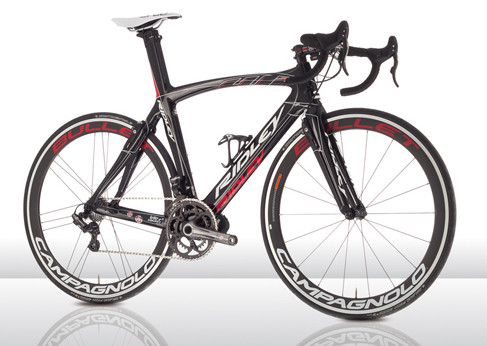Road Racing Bike

This is your traditional racing bicycle; it is designed for going fast on smooth, paved roads. There are usually few concessions to comfort, and the position is long and low for aerodynamic benefits. Road bikes are built to be incredibly light but also stiff so that every bit of effort exerted by the rider shoots straight out of the back wheel.
Frame sizes are usually measured in centimetres, with most good brands offering 2cm size intervals to ensure that their bikes fit most people. It was once customary to be measured for your road bike frame to ensure a perfect fit. However, with the advent of high-quality, low-cost manufacturing in the Far East (usually Taiwan or China), frames are now sold "off-the-peg" in standard sizes. Geometry can vary slightly from manufacturer to manufacturer and it is important that whatever frame you opt for fits perfectly. To ensure a good fit, it is advisable to visit a specialist bike shop that offers bike fitting services. Adjustments can be made to the riding position of the bike by using different stem lengths and angles, handlebar shapes and widths, crank lengths, and seatpost setbacks.
Second to the frame, the wheels of the road racing bike are the next most important contributory factor to the way that the bike rides. Traditionally, racing cyclists would choose their own hubs, spokes and rims of preference and take them to their local experienced wheelbuilder. These days, factory-built wheelsets are much more common. These lightweight aluminium or carbon rims, butted steel spokes and state-of-the-art hubs are built by robots in a factory and are often finished by hand. Factory-built wheels are generally cheaper and often lighter than their handmade counterparts, but do not tend to last as long and are not usually as robust.
Gearing on road racing bikes is usually very fast, with a narrower band of adjustment than other bikes. This is to ensure there are no big gaps between gears that would interfere with the cadence of the rider and therefore their speed whilst riding closely with others in a pack. Gears are now shifted with integrated brake/gear levers, and the way that they are operated varies from manufacturer to manufacturer. Battery-powered electronic drivetrains are becoming more and more popular at the upper end of the market, offering the advantages of lightning-fast reliable shifting, and all-condition reliability.
Modern road racing bike design tends to be led by an emphasis on either light weight (for very hilly and routes with lots of climbing), or superior aerodynamics (for flatter courses) and many manufacturers offer options catering for both disciplines.
Related Bikes:
- Sportive / Endurance Road Bike
- Triathlon / Time Trial Bike
- Audax / Randonneur Bike
- Touring Bike
- Cyclocross Bike
- All-Road / Gravel Road Bike
- Singlespeed / Fixed Gear Bike
- Track Bike
- Porteur
- Flat Bar Road Bike
Return to Types of Bicycle


